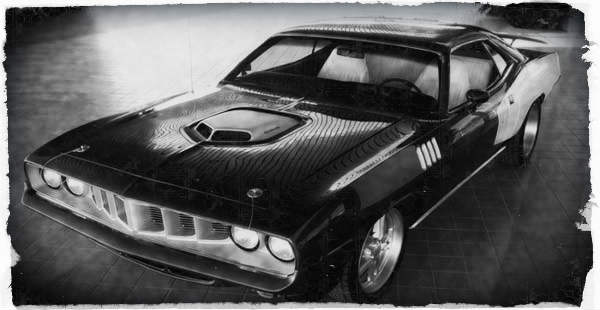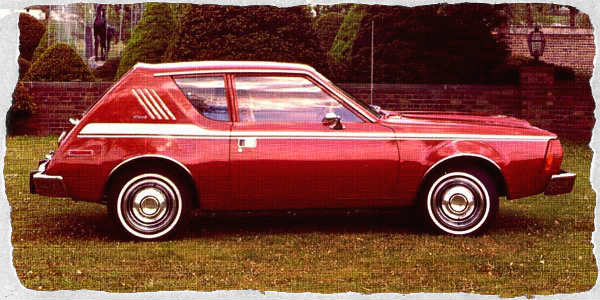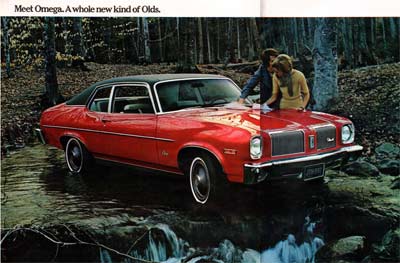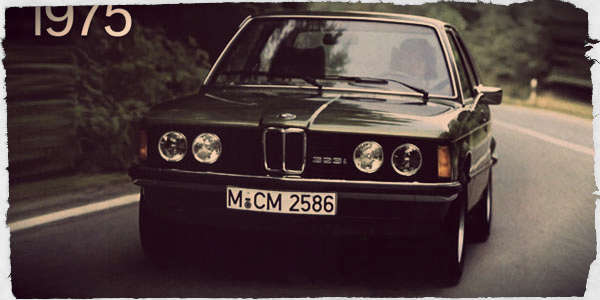
Car manufacturers were dealt some serious challenges in the 1970s. Federal regulations were starting to take over style and power design meeting rooms and many of the cars style took a major hit.
Muscle cars in the early 1970s, like the Challenger, Cuda and Corvette were unbelievably great. But sports cars were overtaken in the mainstream by the compact car because automakers were having an impossible time keeping the power and getting rid of the smog.
By 1972, compact cars had won the sales race. The GM Vega, Ford Pinto, and AMC Gremlin battled the imports – most notably Volkswagen, Toyota, and Datsun.
In 1974, BMW introduced the first 3 series. One of my favorite cars ever, the old school Jaguar XJS was also released that year. Hatchbacks were extremely popular as well.
Cars in 1970
 In 1970 the American automobile industry was under threat from several angles. Falling sales, a 57-day strike at General Motors idling around 347,000 workers, and higher quality foreign cars were the primary culprits.
In 1970 the American automobile industry was under threat from several angles. Falling sales, a 57-day strike at General Motors idling around 347,000 workers, and higher quality foreign cars were the primary culprits.
In an attempt to compete with foreign manufacturers, U.S. carmakers introduced a few lines of ultra-compact cars, but it didn’t seem to curb foreign sales one bit. For the second time in history, foreign sales topped a million units.
AMC (American Motors Corporation) introduced a compact car known as the Gremlin. Ford released the Pinto and GM/Chevrolet came out with the Vega. Chrysler delayed plans for a U.S.-built mini car and instead imported the Plymouth Cricket and Dodge Colt.
The Volkswagen Beetle was the leading import in 1970.
1971 models saw no major design changes. A few station wagon options were added to compact cars, but for the most part 1971 models looked very similar to their 1970 counterparts.
At the beginning of the year, GM announced an average $208 price increase from the previous year. After the strike however, they added another $24 to the increase. Ford added $175 and Chrysler boosted $119. The U.S. Bureau of Labor said that new safety features added approximately $10 value to each car.
For 1971 models, major manufacturers shifted away from the standard 5-year (50,000 mile) powertrain warranty to a 1-year (or 12,000 mile) plan.
Auto insurance companies led a strong push to demand that automobile manufacturers add low-speed bumpers to cars. These bumpers were created to prevent disproportionate and sometimes severe damage done to cars travelling under speeds of 5 mph.
California lawmakers continued to push for greater pollution control. The Nixon Administration and the auto industry opposed regulation and refused to set a firm deadline for emission control changes.
In December, Lee Iacocca became Ford Motor Company’s President.
Cars in 1971
Unfortunately for consumers, almost nothing changed about the automobile industry in 1971. American manufacturers still touted their compact cars. Foreign manufacturers still performed very well. Hardly any design changes were made, either.
The convertible declined in popularity — neither Chrysler nor AMC offered even one convertible among their lineups. The new emphasis was on sunroofs.
The industry went wild with the newfound success of bumpers, and newer models promised even better versions in the coming years. According to regulations, by 1973, the front bumper must withstand a 5 mph impact, while the rear bumper must be able to handle a 2.5 mph impact without sustaining any damage to safety components such as lights and/or door hatches. The standards were set to get even tougher by 1974.
Instead of muscle cars, auto makers touted fuel efficiency and emission control. Reducing vehicle emissions was a primary focus for car makers in 1971. AMC made headlines by offering a full-parts (except for tires) warranty for 1 year (or 12,000 miles). Most manufacturers covered only the power train and a few other major parts.
U.S. manufacturers experimented with the gas turbine, the electric engine, the steam engine and other power plants, but 1971 saw no major breakthroughs. Most prices were raised between 2 and 3 percent. After a repeal of federal excise tax on new cars went into effect in December, car makers announced future price cuts ranging from $115-$425.
In December 1971, Richard C. Gerstenberg was named Chairman of the board of directors at General Motors after James M. Roche announced his retirement.
Cars in 1972

New car sales in the United States set an all-time record of 10,820,000 in 1972. The
previous high was set in 1971.
On a percentage basis, the import manufacturers lost ground for the first time in several years.
In 1973, compact cars won the sales race. The GM Vega, Ford Pinto, and AMC Gremlin battled the imports – most notably Volkswagen, Toyota, and Datsun.
Chrysler continued to import its Dodge Colt for sale in that segment of the market, but Plymouth Cricket sales faltered.
VW was still king of the import sales market. Toyota was the runner-up with
Richard C. Gerstenberg, GM board chairman, said the average GM worker is paid $5.09 an hour.
Working under numerous federal guidelines, the auto industry continued its trend away from major annual styling changes. Money went into auto safety and antipollution devices.

1973 Oldsmobile Omega: The only new model in ’73
Detroit automakers settled for face-lifting jobs on the 1973s. A bit of metal here or there and some extra paint. But they labored long and hard to meet federal requirements on such items as a 5-mile-an-hour bumper system, material flammability, and the reduction of oxides of nitrogen exhaust pollutants.
The federal government required that 1973 cars be equipped with bumpers that can withstand a 5-mile-an-hour front impact without damage to safety-related items on the car.
Customer Satisfaction was the target of a major AMC move in introducing its 1973 cars. AMC had drawn attention when its 1972 models included an unconditional guarantee on all parts except tires for 12 months or 12,000 miles with no Cost to the buyer.
Carmakers had boasted of pollution controls instead of power in 1972. Buyers complained the changes made winter starting more difficult and cut down acceleration. On 1973s, manufacturers tried some minor devices that, they said, improved the performance of those equipped with anti-pollution systems.
But Detroit ran into objections from the EPA.
Car companies continued to experiment with alternative engines. Chrysler, which spent millions of dollars in the mid-1950s trying to develop an inexpensive, workable gas-turbine engine, won a federal contract in November 1972 to develop a sixth generation of its turbine engine. It was considered a possible replacement for the piston engine.
The German-developed Wankel rotary engine drew particular attention in August when GM said that limited production of a Wankel-powered Vega was possible in two years. A Wankel-powered Japanese import, the Mazda, was already on sale.
Cars in 1973
The were few style changes to the 1974 models. Car makers instead focused their attention on increasing gas mileage, lowering exhaust emissions and adhering to stricter government safety regulations.
The first GM car equipped with an airbag was produced in November. It was a $225 option on the Oldsmobile Toronado. Another safety measure was introduced: the seat belt interlock feature. This system prevented the car from starting until the driver and passenger have fastened their seat belts. Obviously technical problems led to this system being a complete disaster and the feature was not installed or required for 1975 models.
To increase gas mileage, car companies started paying particular attention to body weight, noting that a lighter car gets more miles for the buck. Cars started being made lighter whenever possible.
There was a huge gasoline shortage in 1973, and because of this there was a stronger push research on alternative engines than in recent years. While various scientists experimented with turbine and electric, most were dismissed as too cumbersome and expensive. However, much attention was paid to the Wankel rotary engine produced in Germany. GM was hoping to debut a Wankel-powered rotary engine car, the Chevrolet Vega, by 1975. About 120,000 Mazdas, 80% of them rotary-powered, were sold in the United States.
Cars in 1974

In 1974, the Middle East oil embargo, drastically higher fuel costs and much higher price tags for new cars destroyed consumer confidence and enthusiasm. As new car sales slumped, layoffs and plant closings increased.
U.S. auto production in 1974 decreased 24% from 1973.
Volkswagen was the leading import, but was hit hard by the slumping sales as well.
One of the industry’s issues was trying to determine the customer’s buying taste. Many automakers thought that the demand for compact and subcompact cars would skyrocket because of the fuel shortage and high cost of gasoline. But, after a strong first six months for the small cars, standard and luxury models sold better than expected after summer.
Car prices jumped substantially in the 1975 models. However, the price picture was difficult to clarify because automakers shuffled standard and optional equipment on their cars.
GM complained that if 1976 standards requiring stronger brakes and 1977 standards that call for airbags were approved, the price of cars would increase even more.
BMW introduced the 3 series. One of my favorite cars ever, the old school Jaguar XJS was also released that year.
Hatchbacks were increasing in popularity and Buick responded by coming out with the Buick Skyhawk — a quintessential mid-seventies car.










































































































































70’s automobiles. Where to begin. While American car manufacturers were being inundated with regulations by the government and insurance companies. the real downturn began in 73 and on. As usual, they responded in true American fashion: make it cheaper, not better. For example, 5 mph bumpers. Redesign cars? Hell no, just slap some goofy looking bumpers on there and all is well. As for performance, make the body decals bigger and flashier and “HOLD ON, BETSY”!!!!! All the while, the Japanese saw this and responded the way the Americans should have. Ergo, the beginning of the Japanese onslaught. American car makers are still making up ground to this day. The domestic car makers believed thoroughly that the “Buy American” slogan would save them from their self- induced suffering, but the true sufferers were the American public. Beware of purchasing one of these gems as “classic”. They were and are JUNK!!!!! You have been warned.
I must say that my most beloved car of the 70’s was a 1974 Ford pinto. You could fix anything on this vehicle as long as you had a hammer and Phillips’ head screwdriver. Slight exaggeration.
Its gas mileage wasn’t even close to what you might expect out of a car that size with a “four banger” (4 cylinders). I must say though that it got me anywhere I needed to go and isn’t that what you want in a car? My worst was a 77 Dodge Magnum. It was barely 6 months old when a transmission leak sprang from a line that was rubbing against the transmission itself. I wondered what that noise was.
There were various other problems and I ended up trading it in for a 80 Plymouth TC3. Goodbye 70’s. Drive a ’76 roadrunner and a ’69 roadrunner and my previous statements will be a thundering “Nuff SAID!” Anyway, there were some good cars in this decade. Unfortunately, most of them were foreign. All in all, I’d put my Pinto against any Gosh Darn Toyota!
The 1979 Plymouth TrailDuster image is in fact a Jeep Nukizer 715.
I had many American Car in my time. Starting with 1967 Chevrolet Impala SS 327. Always had something wrong with it. 1970 Ford Torino Not a good Idea. 1969 Pontiac Bonneville, Drank gas like water. 1973 Impala was the same. 1974 Chevrolet Caprice Classic was a nice looking car and had no problems. 1977 Ford Thunderbird which should of never purchased one. Nothing but problems. 1977 Chevrolet Malibu 305 under powered but no major problems just brake problems in some ways that is a very big problem. 1977 Buick Regal V6 nice car if the transmission would work. Most of the time just parked. 2005 Chevrolet Malibu banging noise in the front end drove me craze but a reliable car. 2006 Pontiac grand Prix GT nice car i just drove it to much . I finally broke down and purchased a brand new car. 2014 Volkswagen Jetta. Currently have 55,000 miles and not one problem very satisfied with the car, ride is fairly good. My Wife wanted a new 2016 Chevrolet Cruse and now has 24000 miles and not one problem. Driving the Cruse is like driving a luxury car just feels so nice to ride in and to drive. If i get around to Purchasing another new car I want the new Chevrolet Impala. will see. I love the looks of the American car of the 60’s, 70’s styling was so creative and a lot of new technology that was new at the time now just old fashioned.
You forgot Fiat 131 Mirafiori. İt was a good car.
I love learning about the car industry of the 60’s,70’s and 80’s. I drove mostly pickup trucks growing up but I also worked as a tow truck driver for 3-4 yrs when I was fresh outta highschool. I towed so many Chrysler’s with the famous ballast resistor problems(a real easy fix) and there starters or solenoids going out.
I can’t say enough good things about my first two vehicles as a teen. A 72 Ford f250 with a 360 motor and auto trans. Then a 72 Chevy k5 blazer 350 motor &turbo 350 trans. Beautiful orange/red color. I beat the hell outta those trucks and they took it for the most part. Good times… Sorry to ramble
My first love was a 73 El Camino with a 350. Ran it for about a year and never a problem. Next a 76 Grand Prix with a 400, always carb problems that went away on their own also driven about a year. My next car was another 76 Grand Prix with the 455, loved her! Never a problem and I beat her, even took it off road a few times. After 8 years I finally had to let her go. All the floors from pedals to tail lights were rotted out. I replaced them twice throughout the eighties. I refused to buy an 80s car and got myself a 76 K5 Blazer with a 350. After 2 years I blew a head. Rebuilt the engine and drove her a few more years. She was a tank. Pulling out of snow buried up to her door handles was a breeze. Saved my life once in a snow storm when some jackass pulled out in front of me. No time to stop I steered her into the ditch and motored about a mile in two feet of snow before I was able to get back out onto the highway. After the blazer I hit hard times and sold the K5 and picked up a 84 Chrysler Aries Station wagon “K car”, rebuilt the carb and drove her 2 years trouble free until a head gasket started to leak oil and the 4 banger would catch fire from time to time on hot summer days. I bought a 2 door ’80 Parisienne with the 305. Loved it, it rode like a Cadillac. Not the fastest car I ever drove but it was comfortable.
I can remember the 1971-1975 Chrysler line up.I also remember the 1977-1979 Pontiac line up.Not only these but the Cadillacs of 1979.
Dennis from Sydney Australia, !983 Camaro in red. I bought it in 1994, still own it today, has the 305 V8 with T 700 four speed overdrive It runs great and looks new.. It is right hand drive.. The transmission was rebiult in 2001 I have a 2016 Mustang 5 litre GT . The Camaro gets all the looks. I was even filmed whilst driving the Camaro by strangers beside me .Using their I Phone.
If you HAD to buy a new car in the 70’s it was most likely going to be an import, as the “muscle cars” were gone due to regulations, and American cars had not yet built a reliable compact car, which is what everyone needed then with the fuel crisis. Toyota and Honda built solid, reliable cars that got good mileage, and Toyota built trucks that would pretty much last forever and got 20 mpg, or you could buy a Mitsubishi that was dang near indestructible and also got good mileage (but was sold with Chrysler or Plymouth nameplates.) I mean if you HAD to have a full sized truck, Dodge was indestructible but only typically got 6 mpg, so Fix or Repair Daily’s or Chevy’s that got 10 to 12 mpg and didn’t have to meet the emissions standards for the first few years were your other bet.
We had VW bugs, the original Honda Civic, a Toyota Corolla, a Plymouth (Mitsubishi) Arrow pickup, and a Toyota pickup in that era. Also had an old stovebolt Chevy truck (not a “modern” 70s truck) that had an engine rebuilt about 3 times, because it was so cheap, and you could basically fix anything on it with duct tape.
Oh and if you DID buy one of the gashog but emissions restricted American cars or trucks, the first thing you did was take the catalytic off, along with the air pump and any associated junk, take out the PCV valve etc. and get better mileage and performance out of it. I mean you did if you lived anywhere there wasn’t emissions tests required. No one ever actually checked to make sure that junk stayed on them.